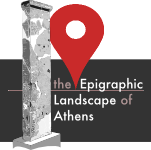Updates #4: Athenian state decrees between II and I cent. BCE
by Stefano Tropea
Between the II and the I cent. BCE, in the Greek world shaped by the Romans after 168 and 146 BCE, the epigraphical landscape of Athens appears to undergo an evolution that paralleled the redefinition of political relationships both outside and inside the polis. If on one side the Athenian institutions still dedicated great attention to juridical and religious issues, it was again on the honours to local individuals and groups that they concentrate their energies in the attempt to provide the community with several exempla of virtuous citizens. In this respect the period starting with the second half of the II cent. BCE witnesses the strengthening of the tendency of the previous decades, already noticed by Liddel, to exploit the Agora as a place of display for public decrees along with the Acropolis, whose ideological function however does not appear to have weakened. If the Acropolis plateau and particularly the area of the Erechtheion complex continued to house many decrees concerning religion and international politics, the eastern section of the Agora dominated by the Stoa of Attalos - ideologically looking towards the area of the Hellenistic gymnasia - became more and more crowded with inscribed stelai, statues and portraits linked with the ephebate. The core documents of my research is then represented by the Athenian state decrees issued on various matters between the middle of the II cent. and the last years of the I cent. BCE. Within this group of texts it has been possible to discern more restricted documentary units of inscriptions dealing with similar matters. My purpose has been to verify for every group selected the possible existence of homogeneous “archives” of inscriptions in the most significant places of the asty.
Stefano Tropea (Turin)
Published on: 19 Nov 2018 by Chiara Lasagni



